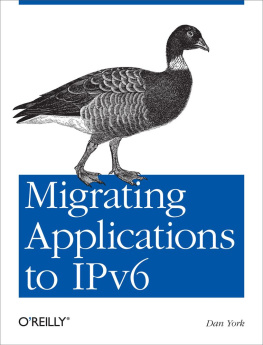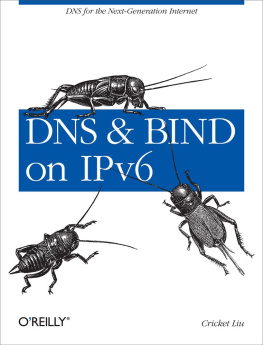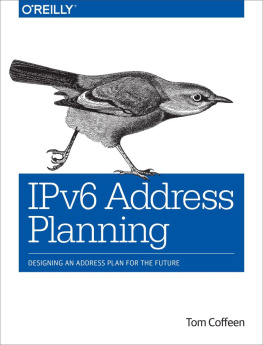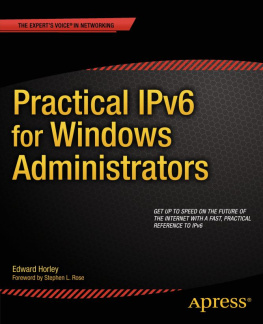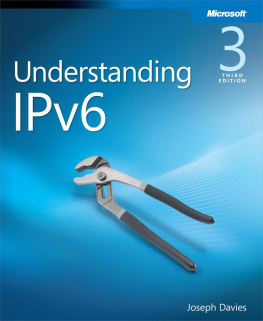Cerf Vint - IPv6 Essentials
Here you can read online Cerf Vint - IPv6 Essentials full text of the book (entire story) in english for free. Download pdf and epub, get meaning, cover and reviews about this ebook. City: Boston, year: 2014, publisher: OReilly Media, Inc., genre: Home and family. Description of the work, (preface) as well as reviews are available. Best literature library LitArk.com created for fans of good reading and offers a wide selection of genres:
Romance novel
Science fiction
Adventure
Detective
Science
History
Home and family
Prose
Art
Politics
Computer
Non-fiction
Religion
Business
Children
Humor
Choose a favorite category and find really read worthwhile books. Enjoy immersion in the world of imagination, feel the emotions of the characters or learn something new for yourself, make an fascinating discovery.
- Book:IPv6 Essentials
- Author:
- Publisher:OReilly Media, Inc.
- Genre:
- Year:2014
- City:Boston
- Rating:3 / 5
- Favourites:Add to favourites
- Your mark:
- 60
- 1
- 2
- 3
- 4
- 5
IPv6 Essentials: summary, description and annotation
We offer to read an annotation, description, summary or preface (depends on what the author of the book "IPv6 Essentials" wrote himself). If you haven't found the necessary information about the book — write in the comments, we will try to find it.
IPv6 Essentials — read online for free the complete book (whole text) full work
Below is the text of the book, divided by pages. System saving the place of the last page read, allows you to conveniently read the book "IPv6 Essentials" online for free, without having to search again every time where you left off. Put a bookmark, and you can go to the page where you finished reading at any time.
Font size:
Interval:
Bookmark:
Silvia easily distills complexity out of IPv6 to make it accessible to everyone.
Latif LadidPresident, International IPv6 Forum
The best vendor-independent IPv6 book available: unpretentious, casual, and powerful.
Joe KleinCEO Disrupt6, and Security SME for the IPv6 Forum
Silvias ability to capture IPv6 in such detail while considering the business and market drivers really sets the stage for deployment, discovery, and innovation. IPv6 Essentials is a go-to resource for all of our students and employees, providing a foundation for the next generation of engineers.
Erica JohnsonDirector, University of New Hampshire InterOperability Lab
As IPv6 enters mainstream deployment around the world, IPv6 Essentials is more essential than ever. This update contains critical new information for any network professional involved in transitioning a network from IPv4 to IPv6.
Mark TownsleyCisco Fellow
It is no exaggeration to say that the Internet has become an integral part of the lives of nearly three billion people on the planet. More important, it touches nearly everyone thanks to the ramifications of transactions, information exchange, and other Internet-based applications that produce indirect effects. The original Internet Protocol provided for a maximum of 4.3 billion terminal identifiers (addresses). This limit was stretched using a mechanism called Network Address Translation that permitted multiple parties to use private address space that would not be exposed in the public Internet but rather translated into a shared, publicly routable IPv4 address. The IPv4 address space was exhausted at the Internet Corporation for Assigned Names and Numbers (ICANN) in February 2011, leaving Regional Internet Registries to deal with the allocation of their remaining address space. IPv6 was developed in the mid-1990s and standardized by the Internet Engineering Task Force (IETF). It has provision for 340 trillion trillion trillion addresses. Its implementation has been slow, but two milestones are triggering an increased rate of uptake. One is the running out of the IPv4 address space. The other is the growing demand for Internet addresses to be assigned to mobiles, set-top boxes, automobiles, and literally tens of billions of other programmable devices. This is the so-called Internet of Things .
In addition to satisfying what will become an insatiable demand for address space, IPv6 has features that improve the Internet Protocol format for easier processing and provides for additional functionality in the way of configuration convenience and flow management, among other useful properties. Readers will find this book an easily approached guide to IPv6 implementation. That IPv6 must coexist for an uncertain period of time with IPv4 is a given, so attention is drawn to so-called dual-stack implementations. A thorough implementation of IPv6, however, must also demonstrate that the implementation can operate in a pure IPv6 environment in addition to coping with a mixed IPv4/IPv6 environment.
Like many exponential phenomena, IPv6 may well come to surprise us. It has been many years since its development, but there is indication that it is approaching 3% of traffic on the Internet. While this seems very small, it will grow rapidly if history is any guide, presuming continued compounding growth of need for the larger address space.
Anyone serious about making a career in Internet-related applications and services will be wise to become familiar with this new protocol and its functionality and capability. You have this opportunity before you in Silvia Hagens work.
This book is about the next-generation Internet Protocol. We have become familiar with the strengths and weaknesses of IPv4; we know how to design and configure it, and we have learned how to troubleshoot it. And now we have to learn a new protocol? Start from scratch? Not really. The designers of IPv6 have learned a lot from over 15 years of experience with IPv4, and they have been working on the new protocol since the early 1990s. They retained the strengths of IPv4, extended the address space from 32 bits to 128 bits, and added functionality that is missing in IPv4. They developed transition mechanisms that make IPv4 and IPv6 coexist peacefully and that guarantee a smooth transition between the protocols. In fact, this was one of the major requirements for the development of the new protocol version.
So you do not need to forget what you know about IPv4; many things will feel familiar with IPv6. When you get started, you will discover new features and functionalities that will make your life a lot easier. IPv6 has features that you will need in tomorrows networksfeatures that IPv4 does not provide.
One of the cool features built into IPv6 is the Stateless Autoconfiguration capability. Havent we always struggled with IP address assignment? The advent of DHCP made our lives easier, but now we need to maintain and troubleshoot DHCP servers. And when our refrigerator, swimming pool, and heating system as well as our smartphones and the TV set each have IP addresses, will we need a DHCP server at home? Not with Stateless Autoconfiguration. If you have an IPv6-enabled host, you can plug it into your network, and it will configure automatically for a valid IPv6 address. ICMP (Internet Control Message Protocol), which is a networkers best friend, has become much more powerful with IPv6. Many of the new features of IPv6, such as Stateless Autoconfiguration, optimized multicast routing and multicast group management, Neighbor Discovery, Path MTU Discovery, and Mobile IPv6, are based on ICMPv6.
I hope that this book will help you to become familiar with the protocol and provide an easy-to-understand entry point and guide to exploring this new area.
This book covers a broad range of information about IPv6 and is an excellent resource for anybody who wants to understand or implement the protocol. It is also a good read for people who develop applications. IPv6 offers functionality that we did not have with IPv4, so it may open up new possibilities for applications. Whether you are the owner or manager of a company or an IT department; whether you are a system or network administrator, an engineer, or a network designer; or whether you are just generally interested in learning about the important changes with IPv6, this book discusses economic and strategic aspects as well as technical details. I describe interoperability mechanisms and scenarios that ensure a smooth introduction of IPv6. If you are a company owner or manager, you will be most interested in Chapters , which address transition mechanisms, interoperability, and planning. If you are a system or network administrator, all chapters are relevant: this book provides a foundation for IPv6 implementation and integration with IPv4.
This book covers IPv6 in detail and explains all the new features and functions. It will show you how to plan for, design, and integrate IPv6 in your current IPv4 infrastructure.
This book assumes that you have a good understanding of network issues in general and a familiarity with IPv4. It is beyond the scope of this book to discuss IPv4 concepts in detail. I refer to them when necessary, but if you want to learn more about IPv4, there are a lot of good resources on the market. You can find a list of books in .
In explaining all the advanced features of IPv6, this book aims to inspire you to rethink your networking and service concepts for the future and create the foundation for a real nex-generation network.
Font size:
Interval:
Bookmark:
Similar books «IPv6 Essentials»
Look at similar books to IPv6 Essentials. We have selected literature similar in name and meaning in the hope of providing readers with more options to find new, interesting, not yet read works.
Discussion, reviews of the book IPv6 Essentials and just readers' own opinions. Leave your comments, write what you think about the work, its meaning or the main characters. Specify what exactly you liked and what you didn't like, and why you think so.




